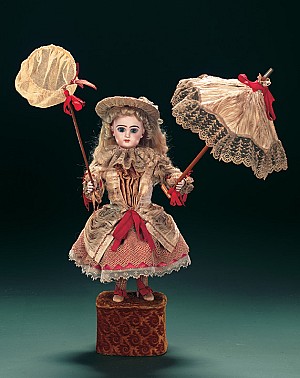Rare French Coin-Operated "Clown Illusionist" Musical Automaton Attributed To Phalibois
Lot #74
6' 7" height. A handsome,floor-standing,oak-veneered cabinet,with gallery and finials,frames a theatrical staging that is fronted by a glass-paneled door. Posed in the theatre is the star performer,a clown,with painted paper-mache head and hands,smartly redressed in black jacket,lustrous white shirt and waistcoat,turquoise blue breeches and pale yellow stockings with black shoes. He holds a black fan in his right hand and a gigantic black die in his left hand which rests upon a metallic gold table decorated with a musical lyre. The lower half of the professionally-refinished cabinet contains a separately-wound and independently operated Regina disc-musical box,along with storage drawer for paper materials. Movements and Music. The mechanism contains a set of six,carved wooden cams in the signature Phalibois style. At the drop of an old English penny,the clockwork motor is released,and the clown comes "alive". The Clown first nods his head in salutation to his audience,than raises the open fan in his right hand to hide his face. Next,he lowers the fan,revealing that his head has disappeared! Then the die cube lifts open to reveal that his head has re-appeared on the table,under the die. The action repeats,his head is again mysteriously placed upon his head,and finally,the die cube is again lifted to reveal that the tabletop is empty. Accompanying the movement is a rich,great-sounding Regina Music Box of the same era,which has replaced the original Kalliope box. The Regina Music Box is of the desirable,short-bedplate,double-comb style with the original zither attachment and slow/fast control; its manual play/stop control is reached from inside the cabinet. There is a stock of Regina and Polyphon discs in fair/good condition included. Circa 1900. Built as an entertainment piece for amusement in a public place such as hotel lobby or arcade,the automat,or coin-operated amusement pieces,appeared in turn of the century German catalogs such as that of Kallioipe Musikwerke of Leipzig (see illustrations,as shown in Encyclopedia of Automatic Musical Instruments by David Bowers,p. 111),Ernst Holzweissig or Reiner,Pelzer & Co. Some of these coin-operated amusements included French automata. It is certain that Phalibois was among those who supplied the automata,further substantiated by his signature wooden cams that appear on this example. The expensive luxury nature of the pieces,as well as their low survival rate owning to the constant use that they received in public places,makes any example today extremely rare.


































































































































